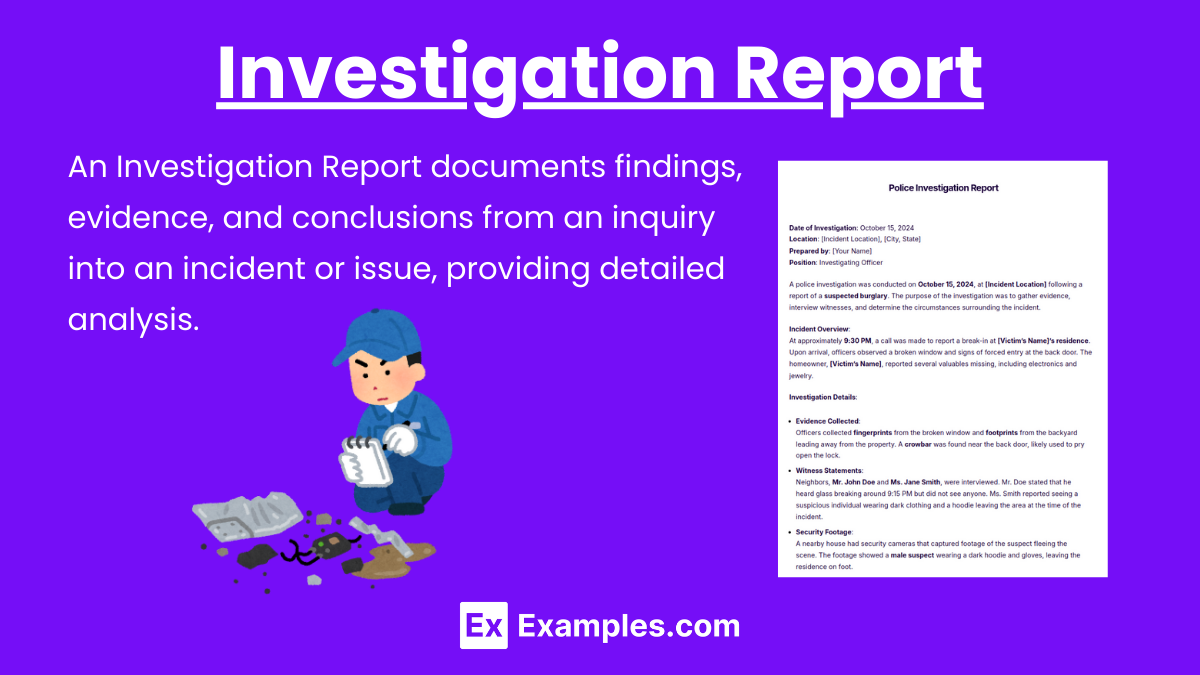10+ Investigation Report Examples to Download
Reports are mainly used to convey important sources of information, observation or an investigation to a specific audience for a specific purpose. Reports structure are often presented in an organized format, made simple for the audience to understand.In some cases, reports are presented to encourage the audience to take a call for action about a certain subject. At times, writers or reporters include certain images, chart examples, graphics and other visuals to reports which can be if great help in grabbing the attention of the reader.
What is an Investigation Report?
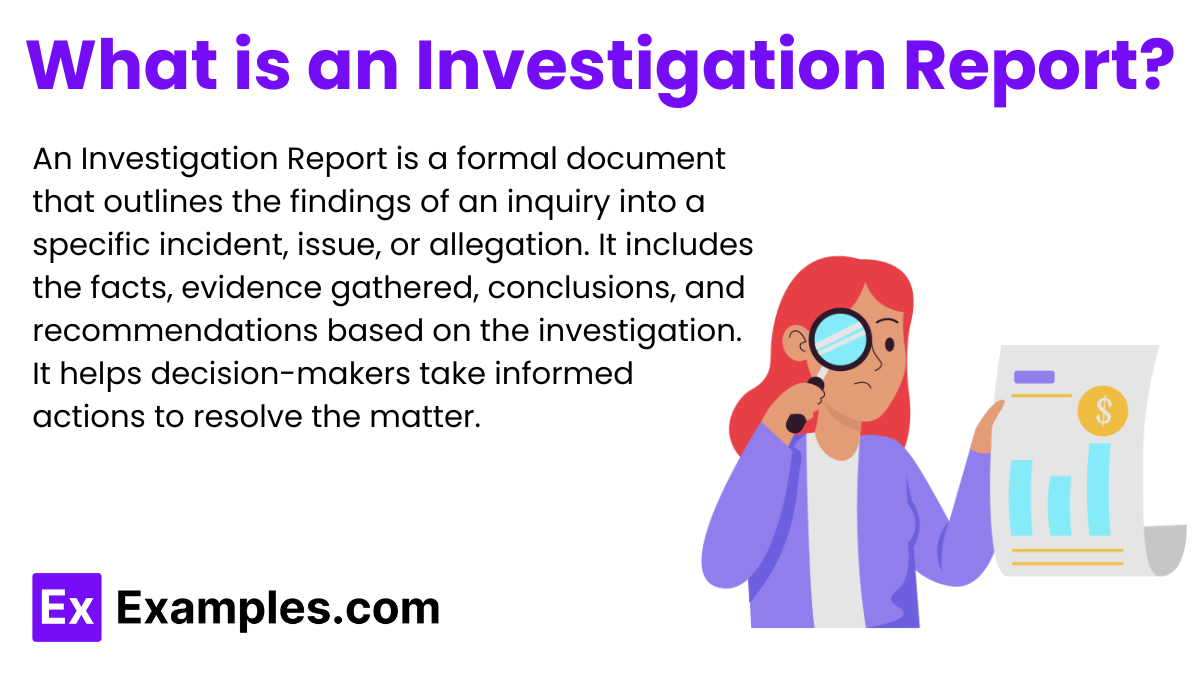
Investigation Report Examples Bundle
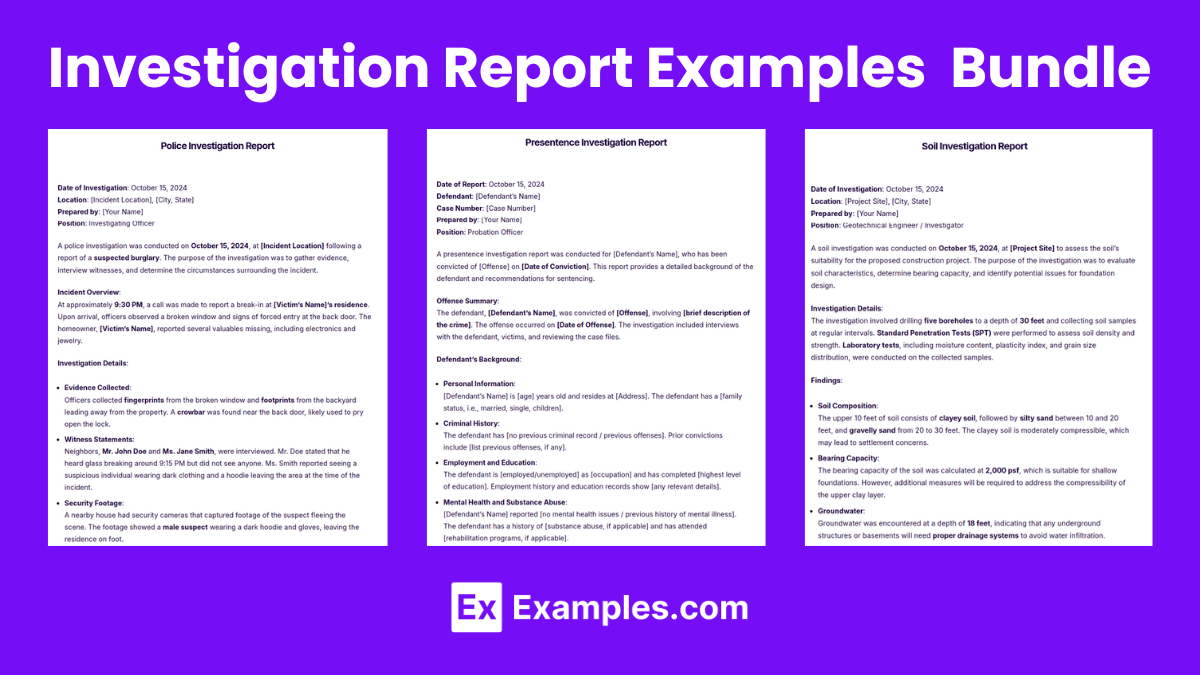
Download Investigation Report Examples Bundle
Investigation Report Format
Title Page
- Title of the Report
- Date
- Prepared for: [Name of the organization or individual who requested the report]
- Prepared by: [Name(s) of the investigator(s)]
Table of Contents
- List of sections
List of Tables/Figures (if applicable)
Executive Summary
- Brief overview of the incident or issue investigated
- Key findings
- Conclusions
- Recommendations
Introduction
- Purpose of the investigation
- Scope of the report (what the investigation covers and does not cover)
- Methodology (describe the methods used to gather information)
Background Information
- Context or background leading up to the investigation
- Details about the subject or parties involved
Investigation Process
- Detailed account of the investigation steps
- Chronological order of events
- Evidence collected (include how evidence was collected and preserved)
- Interviews conducted (summarize who was interviewed and their responses)
Findings
- Presentation of factual findings based on evidence
- Analysis of the evidence
- Identification of any discrepancies, patterns, or significant details
Conclusions
- Summary of what the investigator determines based on the findings
- Confirmation or refutation of initial suspicions or allegations
Investigation Report Example
On October 10, 2024, an alleged bullying incident occurred at [School Name] during lunch recess. Sixth-grade students Jason Wright (victim) and Alex Parker (alleged bully) were involved in a physical altercation over playground equipment. According to Ms. Sarah Johnson, a teacher who witnessed the event, Alex pushed Jason after a verbal argument.
During the investigation, Jason reported that Alex had been teasing him about his appearance before pushing him. Alex admitted to pushing Jason but claimed it was in response to an insult about his family. Both students confirmed the physical altercation but disagreed on who started the verbal dispute.
Interviews with witnesses, including another student, confirmed Alex’s verbal teasing and the physical push. However, there was no evidence of ongoing bullying, and the incident appeared isolated.
The investigation concluded that Alex should receive a three-day suspension for physical aggression. It was recommended that both students participate in mediation and counseling to resolve their conflict and prevent future issues. Additionally, teachers were advised to monitor interactions between the two more closely.
Short Investigation Report Example
Incident Report: Bullying Incident – Playground
Date: October 10, 2024
Involved Parties: Jason Wright (Victim), Alex Parker (Alleged Bully)
Witness: Ms. Sarah Johnson (Teacher)Summary:
An altercation occurred between two sixth-grade students during recess. Jason Wright reported being teased about his appearance by Alex Parker, which escalated into Alex pushing him to the ground. Ms. Sarah Johnson witnessed the incident and intervened.
Investigation Findings:
- Jason confirmed verbal teasing and the physical push.
- Alex admitted to pushing but claimed it was in response to insults from Jason.
- Witness accounts supported Jason’s version of events.
Police Investigation Report
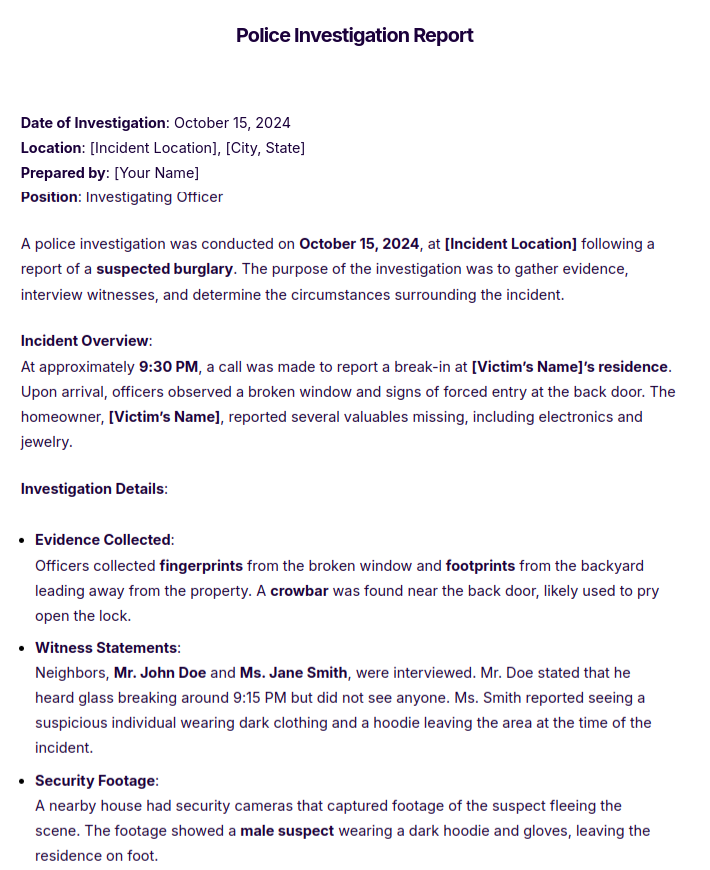
Presentence Investigation Report
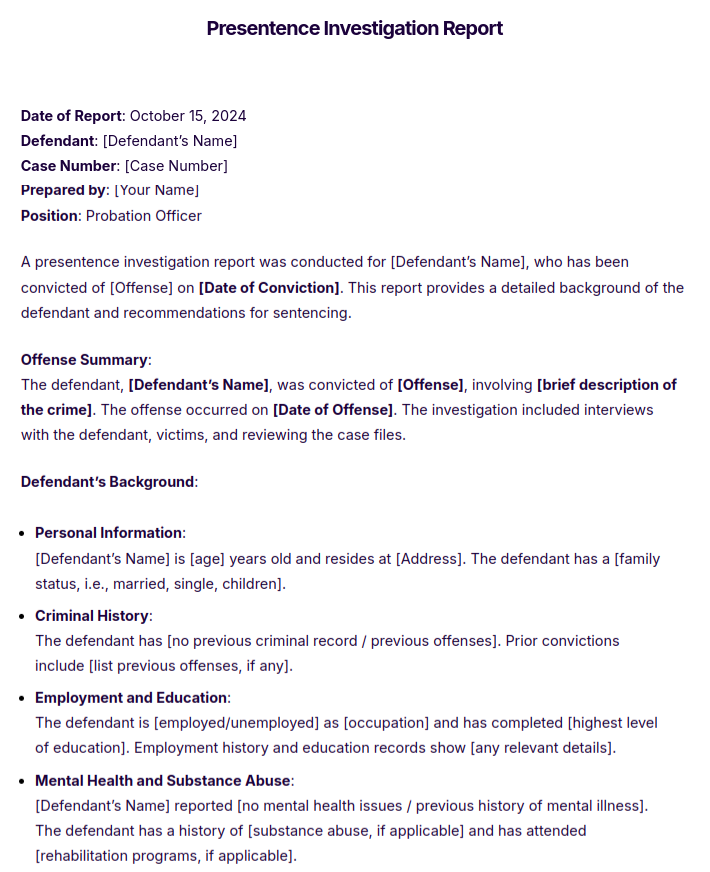
Soil Investigation Report
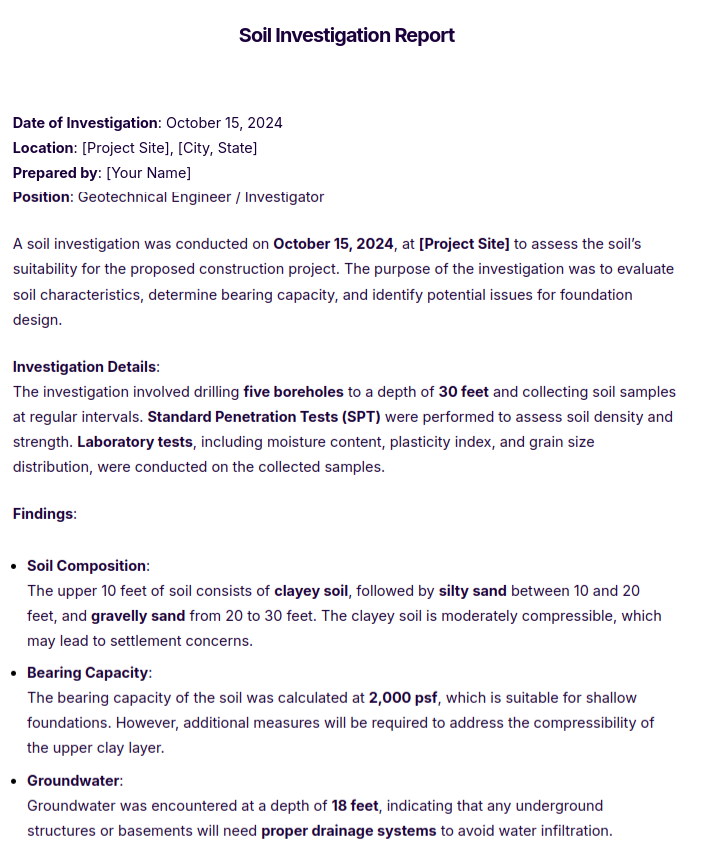
10+ Investigation Report Examples
- Acas Investigation Report
- Investigation Report for Maternity
- Investigation Report for Insurance Claim
- Investigation Report for Medical Claim
1. Incident Investigation Report Template
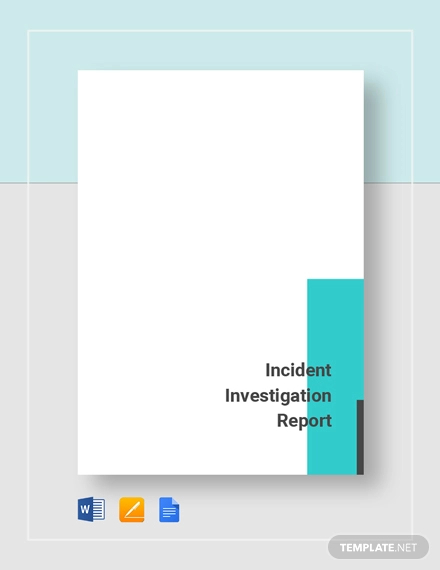
2. Site Investigation Report
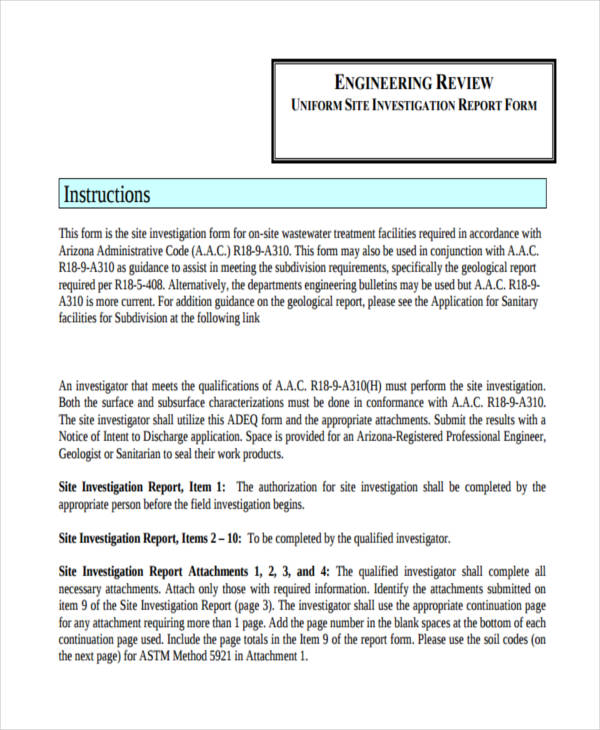
3. Preliminary Investigation
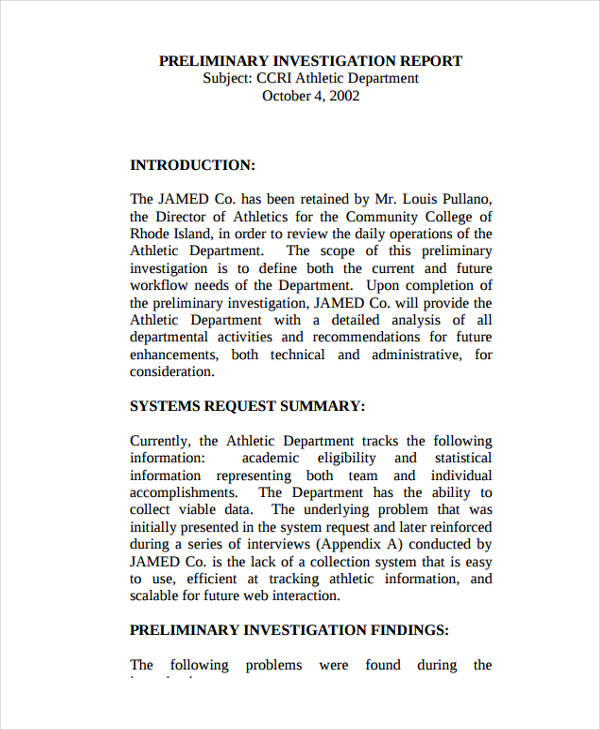
4. Disciplinary Investigation
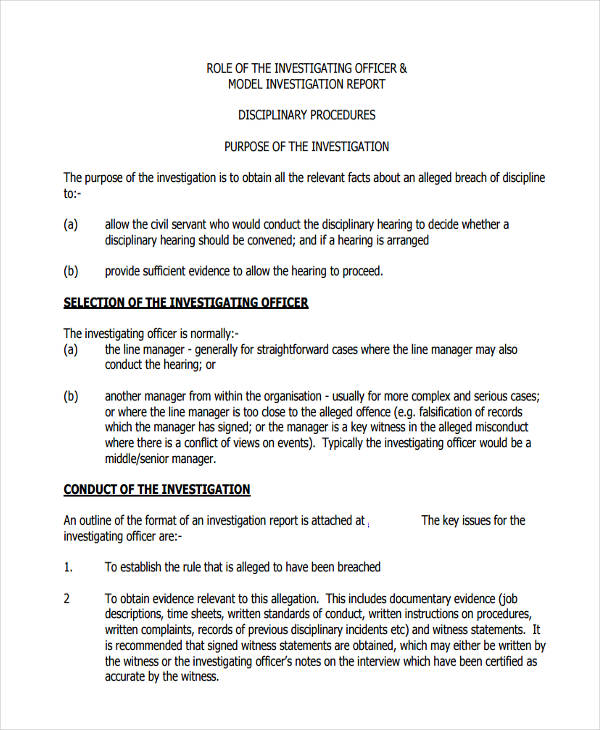
5. Investigation Progress Report

How to Write an Investigation Report?
Writing an investigation report can be a draining process. One needs enough concentration to be able to deliver the essential points of the investigation most clearly and understandably. There are a few key steps you need to follow in writing an investigation report. These steeps are as follows:
Keep the Purpose in Mind
Writing an investigation report can be a draining process. One needs enough concentration to be able to deliver the essential points of the investigation most clearly and understandably. There are a few key steps you need to follow in writing an investigation report. These steeps are as follows:
Collect the Information regarding the Investigation
Research report. Interview people. Gather all the needed data you need for the report you make for investigation. If you do in it advance, then you do not need to run places for details during the writing of your report.
Arrange the Information into Different Sections
Organize your report by dividing the information into different sections, for better understanding.
Mind the Tone and Language
You should always sound formal reports, and of course, use formal language in delivering your report.
Consider the Length
This will depend on the length of the investigation itself. You must keep your reports short because not many people would like to read long reports.
State Accurate Facts
Make sure the facts you share are accurate. In most cases, the reporter is not allowed to include personal or any biased opinions in the investigation report he/she writes, as this can change the whole situation to something one does not want to face. Check management report examples that are available online for more.
Review the Report
Avoid discussing any unrelated information. Revision is one way to improve your report. Simplicity id one crucial factor for your readers to understand in this way, they can understand your report better. Keep the report as simple as you can, so that it is not very tough for your readers to read and understand what you say.
Types of Investigation Report
1. Accident or Incident Reports
- Purpose: To document details of an accident, identify causes, and prevent future incidents.
- Commonly Used: In workplaces to address work-related injuries, in public safety to document traffic accidents, and in healthcare settings to record patient care incidents.
2. Criminal Investigation Reports
- Purpose: To outline the findings of a criminal investigation, including evidence collection, witness statements, and conclusions about the crime.
- Commonly Used: By law enforcement agencies or private investigators to document criminal activities.
3. Fraud Investigation Reports
- Purpose: To examine allegations of fraud, gather evidence, and recommend actions against fraudulent activities.
- Commonly Used: In corporate or financial settings where fraud is suspected, including insurance fraud, financial misrepresentation, or corporate malfeasance.
4. Compliance Investigation Reports
- Purpose: To ensure that procedures and regulations are followed and to address any deviations.
- Commonly Used: In businesses to ensure compliance with internal policies and legal regulations, particularly in sectors like banking, healthcare, and environmental services.
5. Human Resources Investigation Reports
- Purpose: To address complaints and issues related to workplace behavior and ethics, such as harassment, discrimination, or policy violations.
- Commonly Used: Within organizations by HR departments to resolve employee disputes and ensure a safe and equitable workplace environment.
6. Safety Investigation Reports
- Purpose: To investigate safety violations or incidents in the workplace, aiming to improve conditions and prevent recurrence.
- Commonly Used: In industries such as manufacturing, construction, and energy, where safety is critical to operations.
7. Scientific or Research Investigation Reports
- Purpose: To document the methodology, findings, and conclusions of scientific research.
- Commonly Used: In academic and professional research environments, often related to medical, environmental, or technological studies.
8. Technical Investigation Reports
- Purpose: To solve specific technical problems, identify faults, and propose solutions.
- Commonly Used: In engineering, IT, and manufacturing sectors to address system failures, product defects, or process inefficiencies.
9. Audit Reports
- Purpose: To assess financial and operational processes, ensure accuracy, and recommend improvements.
- Commonly Used: In corporate and government sectors to review accounting records, compliance with financial regulations, and operational integrity.
Importance of an Investigation Report
Investigation reports usually provide the audience with a quick view of the investigation that has taken place recently. The main purpose of such a report is that it should enlighten the audience about the subject of investigation and the whole report itself. You can also take a look at technical report templates for more.
In presenting an investigation report, the audience will be able to understand the purpose of the whole investigation and identify whether or not the resources intended for the investigation were used accordingly. An investigation report also gives the audience an idea of the factors, both positive and negative, that are affected by the investigation. This also explains how those conducting the investigation derives the conclusions they provide. Check short report examples for more.
Investigation reports give the reporters a chance to share the results of their investigation. This way, they can also ask the audience for their opinions if any. It can thus be said that the investigation report writing explains the process of the investigation in a way that can be easily understood by others.
How to find a Investigation Report?
- Identify the Source: Determine where the report might originate. For workplace incidents, this would be the human resources or safety department. For academic settings, it could be the school administration or specific department heads. In legal contexts, police departments or legal counsel may hold the report.
- Request Access: Depending on the sensitivity and confidentiality of the report, you may need to request access formally. This could involve submitting a written request or filling out specific forms that outline your need and authority to access the report.
- Search Online Databases: For public reports, such as those involving government investigations or widely reported incidents, search online databases or government websites. Many public agencies publish reports on their official sites.
- Use Libraries and Archives: Academic and legal libraries often have archives that include investigation reports. These can be accessed by visiting the library or sometimes through online portals.
- Contact Involved Parties: If you know individuals directly involved in the incident or the investigation, they may be able to provide or direct you to the report, subject to legal and ethical guidelines.
- Legal Request: In cases where access is restricted, a legal request or subpoena might be necessary, particularly for sensitive or private reports in legal or official investigations.
How to Read an Investigation Report?
- Executive Summary: Start with the executive summary, which provides an overview of the entire report. This section summarizes the incident, the methodology of the investigation, the main findings, and the recommendations.
- Incident Description: Carefully read the description of the incident. This section includes details about what happened, when, and where it took place. Understanding the specifics of the incident is crucial for interpreting the rest of the report.
- Methodology: Note the methods used in the investigation. This can include interviews, forensic analyses, reviews of documents, and surveillance. The methodology informs the reliability and scope of the findings.
- Findings: Focus on the findings section, where the results of the investigation are detailed. This includes direct causes, contributory factors, and any violations of policies or laws. Cross-reference these findings with the incident description to understand the sequence of events and the cause-effect relationship.
- Conclusion and Recommendations: Pay special attention to the conclusions drawn from the findings and the recommendations made. This section outlines the steps suggested to prevent future incidents or rectify issues identified during the investigation.
- Supporting Evidence: Review any supporting evidence, such as photos, documents, or expert statements included in the report. This helps validate the findings and understand the depth of the investigation.
- Appendices and References: Finally, check the appendices and references for additional information or context that can give more depth to your understanding of the report.
How to Send an Investigation Report?
1. Review and Approval
Before sending out the report, it’s crucial to have it reviewed and approved by the relevant authorities or stakeholders. This might include supervisors, legal teams, or department heads. The review process ensures that the report is accurate, comprehensive, and adheres to all necessary legal and procedural standards.
2. Confidentiality Check
Investigation reports often contain sensitive information. It’s important to check that all confidential information is handled according to privacy laws and organizational policies. This may involve redacting sensitive data, securing permissions for sharing information, and confirming that recipients are authorized to receive the report.
3. Format the Report
Ensure that the report is formatted properly and is easy to read. This includes organizing the content with clear headings, subheadings, and an index if necessary. Formatting also involves checking that all appendices and supplementary materials are properly attached and labeled.
4. Choose the Appropriate Delivery Method
The delivery method should reflect the sensitivity and urgency of the report:
- Email: For quick delivery, email is often used. When sending the report via email, use encrypted email if the content is sensitive. Ensure that all files are securely attached, and consider using password protection for PDFs or other document formats.
- Physical Copies: Some situations may require physical copies, especially when legal documents are involved or when digital communication is inadequate. Use a trusted courier service, and send documents as confidential or registered mail.
- Secure File Transfer: For large files or extremely sensitive information, a secure file transfer service that offers end-to-end encryption may be appropriate.
- In-Person Delivery: In some cases, particularly when the findings are sensitive or potentially controversial, delivering the report in person can be preferable.
5. Notify Recipients
Before sending the report, notify all intended recipients about the forthcoming delivery. Provide them with a brief overview of the report’s contents and alert them to any actions they may need to take upon receiving the report.
6. Send the Report
Once all preparations are complete, send the report using the chosen delivery method. Ensure that all electronic transmissions are secure and that physical copies are properly packaged and labeled.
7. Confirm Receipt
Especially in the case of sensitive or critical information, it’s important to confirm that the report has been received. For emails, request a read receipt. For physical deliveries, use tracking numbers and request a delivery confirmation.
8. Follow-Up
After the report has been sent and received, follow up with the recipients to address any questions or concerns they might have. This might involve arranging meetings to discuss the report’s findings and recommendations.
9. Documentation
Keep records of all communications related to the sending of the report. Document when and how the report was sent, who received it, and any follow-up actions taken. This documentation can be crucial for accountability and in case of any disputes or further investigations.
FAQs
What is an investigation report?
An investigation report documents the findings of an inquiry into an incident or issue, outlining facts, evidence, and recommendations.
Why are investigation reports important?
They provide a clear record of events, help resolve conflicts, and ensure accountability and transparency in decision-making.
What should be included in an investigation report?
Key elements include a summary of the incident, evidence gathered, interviews, findings, and recommendations.
Who conducts an investigation?
Investigations are typically conducted by an appointed investigator, such as a supervisor, counselor, or HR personnel, depending on the situation.
How long should an investigation report be?
It depends on the complexity of the case, but it should be concise, factual, and cover all relevant information clearly.


